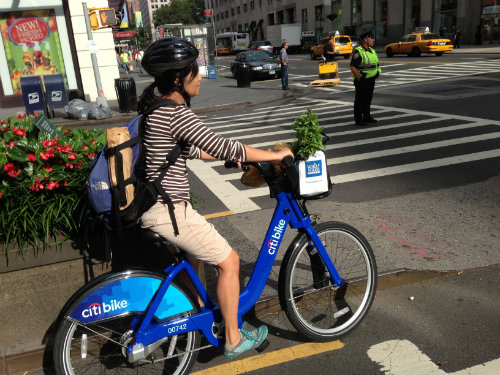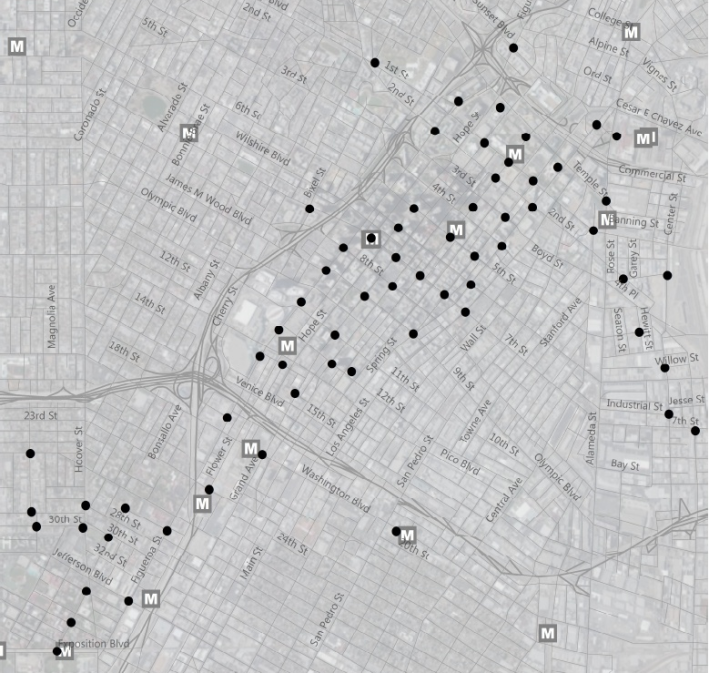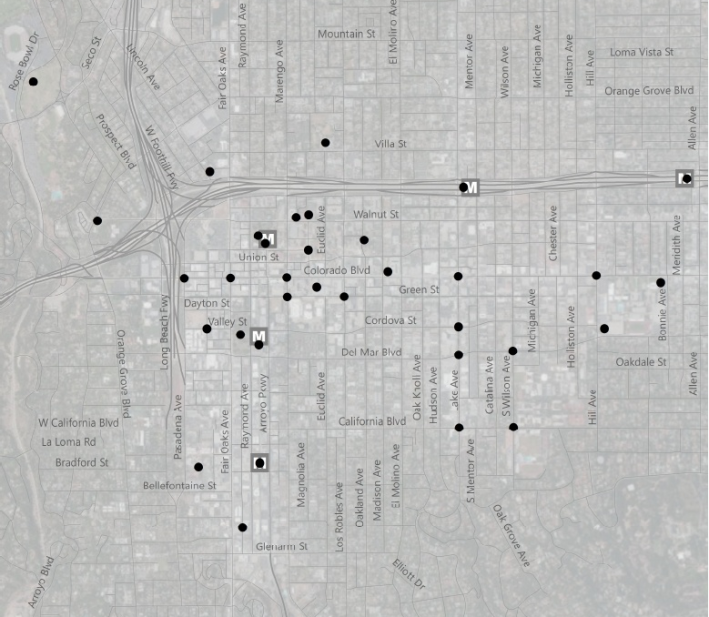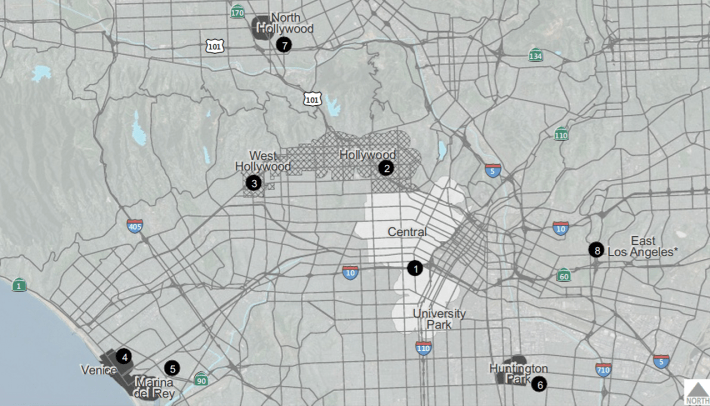
Metro is moving forward with its regional bike share system, expected to debut in downtown Los Angeles in about a year. Metro released its bike share Request for Proposals (RFP) in December 2014, with bids due January 27. A bike share contract is expected to be awarded by June, with full implementation of a 1,000-bike system in downtown Los Angeles nine months later.
Metro's RFP is for an initial two-year contract, with possible extensions up to seven years and expansions to nearly 4,000 bikes in expanded service areas.
Though the initial two years are funded, the overall funding picture is not entirely clear. Metro is soliciting competitive bids, so the agency cannot be too specific regarding system funding and cost. In July 2014, Metro's board allocated $3.8 million for downtown L.A. bike share capital; those funds are from ExpressLanes tolling revenue. Metro officials also mention unspecified state and federal monies.
The initial two-year contract is likely to run somewhere in the ballpark of $10-$16 million.
Metro will own the system, brand it, and manage it, via contractors, but the system will be located in host cities, which Metro will require to share costs. Initial capital costs are split 50/50 between Metro and the host cities. Operations and maintenance will be split, with 65 percent paid by the host city and 35 percent by Metro. The funding is already in place for the initial two-year downtown L.A. pilot, entirely in the city of Los Angeles. The split funding process could complicate later expansion to other municipalities, which tentatively include Huntington Park, Pasadena, West Hollywood, and unincorporated county communities of East L.A. and Marina Del Rey. (See expansion map below.)
Rounding out the funding picture will be some additional bike share system revenue from system users, including memberships (typically single-use, daily, monthly, and annual) and usage fees. Metro's RFP specifies that "[a]dvertising or sponsorship revenue shall not be considered or included" (RFP, page 2-102) in the proposals.
What the Downtown L.A. Bike Share System Will Look Like
If the stars align, downtown Los Angeles could possibly see the first bikes on the ground in this calendar year. After a contract is awarded, expected June 2015, an initial two-month 10+ docking station "test" launch will open in four months. Theoretically that will be October 2015. The full system, including 65 docking stations and 1,000 bicycles, will be implemented within six to nine months of the expected June contract approval. Metro anticipates full downtown implementation to be completed by Spring/Summer 2016.

The recommended initial downtown Los Angeles bike share service area (see map) is a little convoluted; it is shaped like a backwards letter N. It includes Union Station, Civic Center, Little Tokyo, Arts District, Broadway, Financial District, Figueroa Corridor, Staples Center, L.A. Trade Tech College, and USC. Metro Blue, Red, and Expo line stations are well-served. Most of Skid Row, Chinatown, Fashion District, and Central City West are not included.
If bike share goes well downtown, the Metro board can choose to extend the duration of the contract there, and can expand the system to other locations.
What Near-Term Bike Share Expansion Will Look Like
Slated to be first in line for regional bike share expansion will be the city of Pasadena.

The recommended Pasadena bike share station map (above) includes 34 stations primarily in commercial areas south of the 134 Freeway, including all Metro Gold Line stations in Pasadena.
Though some Metro Gold Line riders might use the system at both ends (the first mile / last mile) of a rail trip between L.A. and Pasadena, the overall system utility would likely be better served by expanding contiguously with downtown. Density of stations in a single area yields the greatest transportation utility for the least cost. Metro is a county-wide authority, hence under some political pressure to make sure their systems go beyond just L.A. city boundaries. So, Pasadena is slated for the initial system expansion area, possibly in late 2017, pending Metro board approval.

After Pasadena, again pending Metro board approval, the downtown system would expand west into Koreatown, MacArthur Park, and Echo Park. This would be followed by Hollywood and West Hollywood. Then potentially Venice and Marina Del Rey, North Hollywood, Huntington Park, and/or East Los Angeles.
If all goes as stated in the RFP, then the overall regional bike share system will have 254 stations and 3,812 bicycles.
Metro Bike Share Not All Good News
Though it is important to get something on the ground, and expand from there, just 1,000 bikes is not quite a serious big city bike share system. L.A.'s downtown system will be the same size as Minneapolis-St.Paul's Nice Ride system, and smaller than systems in Washington D.C., Montreal, and, of course, New York City.
Metro's regional bike share system is repeatedly emphasized as a "pilot" with possible liquidation after two years. That two years includes nine months to set up, so the Metro board could conceivably pull the plug after only 15 months of operation. Metro has not demonstrated this tepid a commitment to, say, rail service on the Foothill Extension of the Metro Gold Line. Any bets on whether bike share or the Gold Line extension will have greater overall ridership? Metro operations and maintenance cost for Metro Gold Line free parking lots may rival the ongoing costs for downtown bike share. Both the Gold Line and the regional bike share system are important components of a robust transportation network. Metro should show similar long-term commitment to both.
Metro has backed off from a few ill-advised aspects of their initial plan.
Initially Metro's RFP stated that helmets would be "required." A late December 2014 RFP amendment modified this to "encouraged." This week, Metro staff verbally downgraded that to "suggested," in relation to a possible discount helmet purchase program at local bike shops.
Metro's RFP requires the bike share system to be compatible with Metro TAP fare cards. It is very unclear how this would work, even to Metro. Basic TAP cards can be purchased for a few dollars and bike share systems elsewhere uniformly require a credit card. A significant portion of bike share user fees are for year-long memberships with most individual trips requiring no additional cost. TAP is set up very differently; it mainly deducts fares on a per-trip basis. Also, some TAP technology is proprietary. In a second RFP amendment yesterday, Metro staff clarified that full TAP integration, whatever vague shape it might take, will not be required in the initial phase downtown, but that "Metro’s goal is that the Bikeshare may be fully integrated into the TAP system in the future."
To Be Continued
Many SBLA readers already know that both Santa Monica and Long Beach are implementing bike share systems independent of Metro regional bike share. Last November, Santa Monica approved a 65+station, 500-bike system.
There are a lot of steps to go before Metro bike share rides onto Southern California streets. Keep your browser tuned to SBLA to follow how this important new transportation system rolls out.






